
06/07/2012

Slot.it Lola B09/60
I picked up my new Lola B09/60 today from my friendly raceway, The Race Place, located in Holly Hill, Florida. Many commercial raceways tend to come and go, but this one has been open since 1985 in the same location. I think if you want to race at a commercial raceway, you should make your purchases there as well.
The owner of The Race Place, Greg Walker, is an active slot car racer and has a huge selection of Slot.it and other fine slot cars. The new products get to him very soon and I like to look at the car prior to purchasing it.
Whenever I get a new slot car, the first thing I like to do is look at it. I grabbed my camera and started taking some shots of the car as it was rather impressive just to look at. The Lola was no exception.
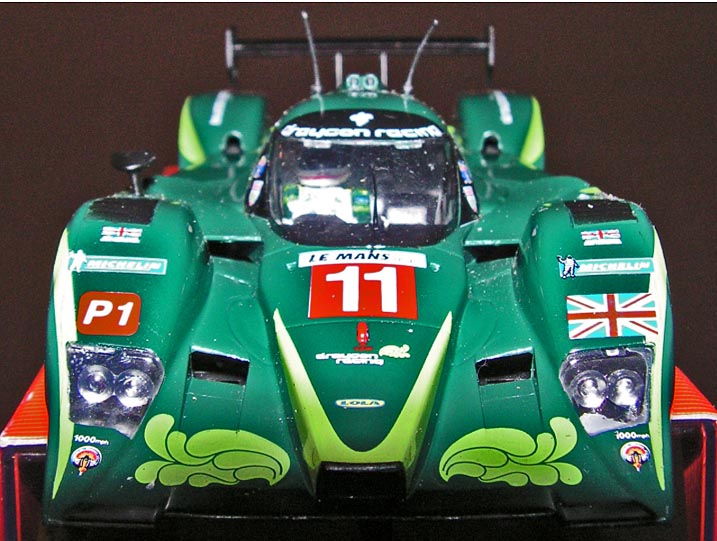
As I started to look at this photo, my mind started really looking at the details on this product from Maurizio Ferrari and the development team.
Yes the right front mirror is not there anymore. I have it in my spare parts box and the one on the left will be removed for racing. They are susceptible to damage because of their location. If you intend to race this car as it was intended to be raced, I would suggest that you remove the mirrors prior to racing it so you won’t spend half the evening trying to find them on the track. They are black and blend in very nicely with the color of the track. Please don’t ask me how I know this!
First, a few more photos of this beautiful Slot.it car.
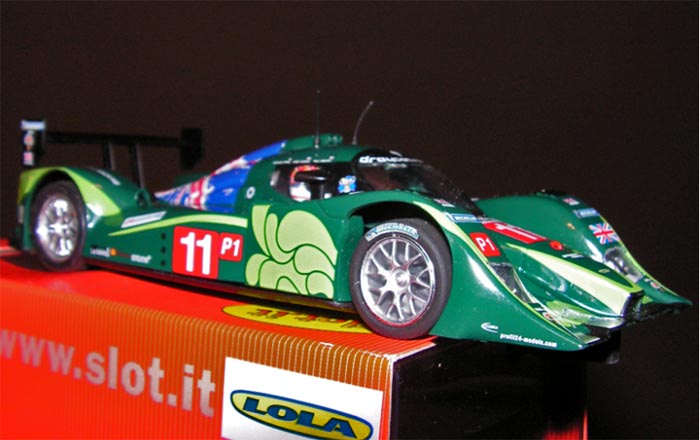
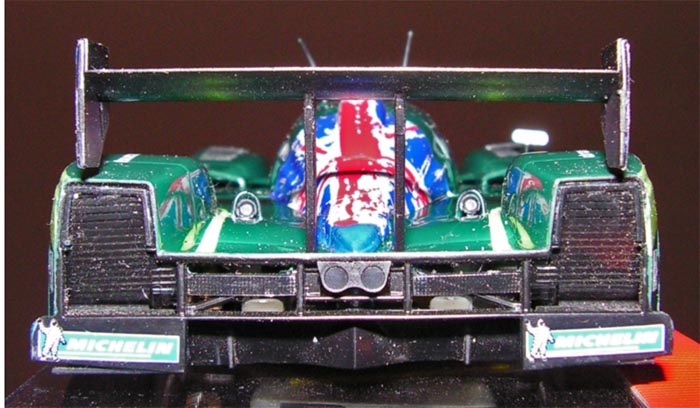
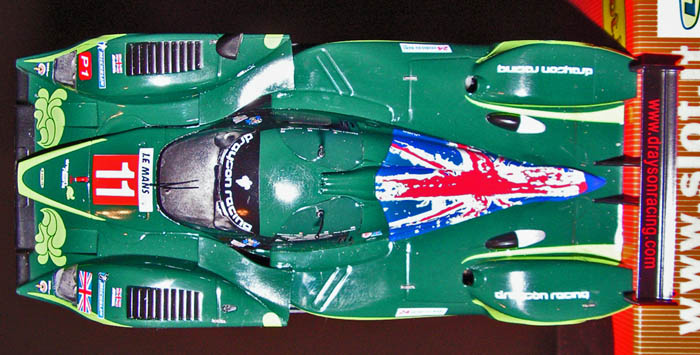
Okay, about now you’re saying let’s get to how it runs!
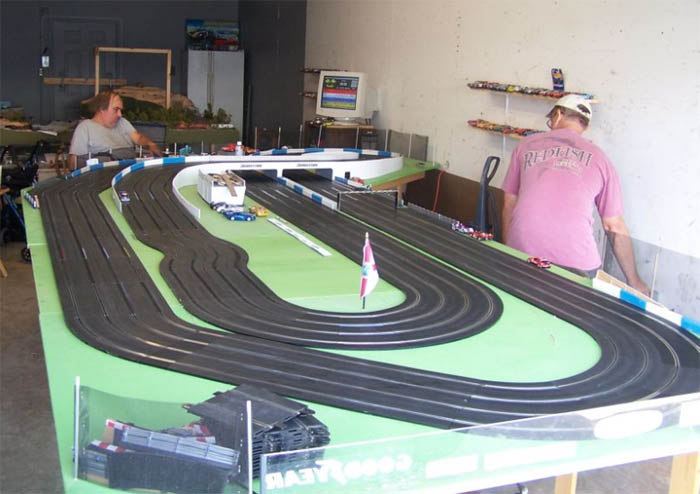
The track that I race at is built using Scalextric Sport track. The lap length is about 67 feet. This is from the Auto Cad program. We have not taken a piece of string and stuffed it into the slot to verify. The track’s surface almost requires a magnet to be installed in the car. So, I am a magnet racer.
At our club, DeBary Glen Raceway, we have a rule of 3X car weight in ‘artificial downforce’. There is a Magnet Marshal and all cars are checked to make sure this limit is NOT exceeded. Hey, the prototype LMP cars strive for about 3X ‘artificial downforce’ so I’m going to take the same advantage.
When I put the Lola on the Magnet Marshal, it weighed 84 grams of car weight and the total ‘artificial downforce’ was 232 grams. I have read where the motor provides about grams of downforce. This total is about 104 grams of magnetic downforce shy of the maximum allowed at our club’s track according to our rules.
There is a notice that the guide that comes with the car should be replaced with the one included ‘under the box’ prior to use. So that was the next thing to do.
I did not have the benefit of the information Slot.it has provided when I replaced the guide. If you go to:
http://www.slot.it/Download/FAQ_PDF_en/13-LMPbraid.en.pdf
There is a photo essay on how to set up the new guides. It is very different from all previous Slot.it guides. Is it better? All I will say is that it is different, but I’ve not had any issues with the wires pulling out of this guide. I found that holding my tongue in a certain position helped. But I would have much rather had the above procedure at my disposal.
I adjusted the voltage to 11.5 volts. This is the “Slot.It” voltage on our track. We find that all of the Slot.it cars run very well on this voltage. Presently “King of the Slot.it” cars is a Ferrari F40 that holds the best time of 4.371 seconds with this voltage setting.
The Lola B09/60 was placed on the track and run around for several laps allowing the motor to loosen up a bit, all the moving parts to run the high spots off and then I brought I back in, lubricated it and put it back on the track.
In the Lola is a Slot.it Flat-6 motor that is rated at 20,000 rpm and provides 220 gram/cm of torque. While it sounds a bit anemic, the power band on this motor is about as wide as the plains in Texas. The power application is very smooth and it is a very drivable slot car.
Without any problem, even with the approximate 130 something grams of artificial downforce, you could slide the rear end out and ‘reach out and touch someone’ any time that you wanted to in a curve. The car is very planted and as the power is increased, it just responds to your inputs.
One of the very small ‘issues’ I did notice on this car was that it was not “Slot.It Quiet” on the track. There was a lot of gear noise. I did some research and it would appear this is a common problem. Maurizio has stated that .5 mm of spacer between the spur gear and the bushing will correct this. He was right. Once I spaced the gear out, the noise went way down.
By the end of the first run around the track, the Lola was turning in respective laps of 5.142 seconds. While it was not setting the land speed record at DeBary Glen, I thought it would work out nicely and be a very competitive car.
A plan was developed that would include a set of Super Tires 1408 rear tires, some ‘grub screws to take advantage of the new included technology (read on) and an adjustment to maximum artificial downforce. I headed off to the bat cave to start making the changes.
The first thing I did was to get some M2 x 3 mm ‘grub screws’ out of the parts bin. Next I put one into each of the ‘body jacking’ locations (see photo below). I brought the head of the ‘grub screw’ up to about .016 or .5 mm to raise the body up from the chassis.
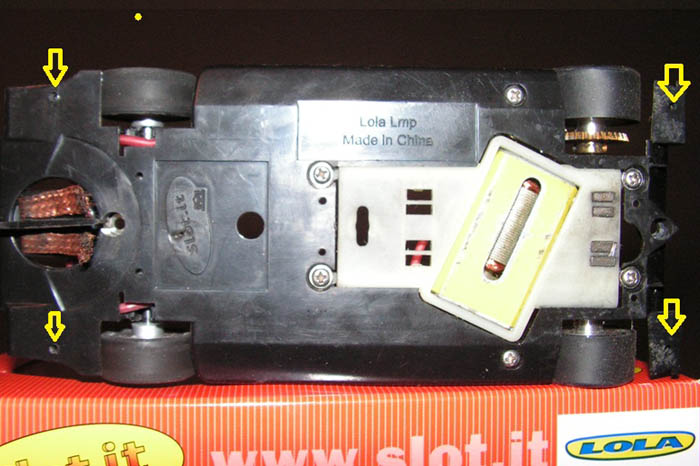
I had run several laps with the gears not in proper mesh. Rather then risk the potential problems of premature gear wear, I chose to replace the supplied gear with a new Ergal anglewinder gear of 27 teeth. Once the gear was installed, I hooked up my bench power supply to 4.0 volts and put the car on my test stand. There was a little bit of gear noise and the current being drawn seemed a bit more then I would expect. A bit of tinkering and one more spacer did the trick. I could put a piece of cigarette paper between the pinion and the crown and it fit perfectly. When I hooked up the power supply again, the current drain was where I expected it, about 115 milliamps.
Next up was to put more artificial downforce on the car. Yes, that means adding some magnets or dropping the existing magnet closer to the track’s surface. I chose to add a small piece of magnet to the existing stock magnet. When the Magnet Marshal read 326 grams, I knew I was pretty close. I chose to stay with that for my next test.
If you look at the above photo of the bottom of the chassis, pay particular attention to the location of the magnet. The ‘new’ anglewinder motor pod that was introduced with the Lola is a CH74. The magnet pocket has been relocated to a position between the back of the motor and is almost directly under the rear axle. This is very different from the motor pod used in the RAW cars and should be available to retrofit to that car. I think if you run any of those cars with a magnet, then you should seriously consider upgrading to this motor pod.
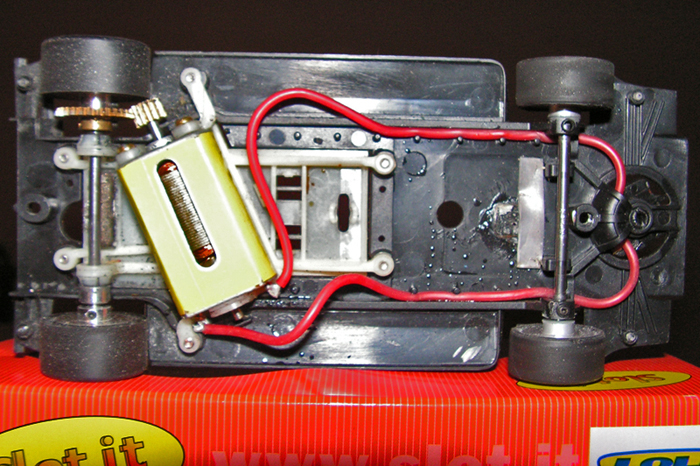
I will be very honest here. I am a speed crazed moron and freely admit it. If I could fit a 426 race hemi into a Yugo, I would. Since I had a Flat-6R motor available to me, I chose to go with the ‘more power’ route. Hey, the Flat-6R is a 22,000 rpm motor with 320 grams / cm of torque. Sounds like a ‘big block’ to me! After several laps with the new motive in place, I replaced it with the stock motor. While it was ‘zippier’ down the straights, the stock motor was easier to driver and provided faster lap times.
The final item I added was a small piece of lead right behind the front axle. It weighs 1 gram and it tends to keep the front end ‘planted’ during operation.
Now I know you are all asking, ‘what kind of lap times did it run?” I put the car on the track; made sure the voltage was adjusted properly on the power supply and started taking some laps to heat up the 1408 Super Tires. Then I wiped them down on a piece of tape and started to push the car just a bit. I took my time and got myself ‘into the zone’ and then I tried taking the car to its limits in each of the 6 turns on the track. After I found each of the limits, I then started my speed run.
From experience, the track will only hold what it will. I know that the current Modern Lemans record that was set with a Slot.it Ferrari F40 was done at night when the ambient temps were much lower then the 90 plus temps during my test session. However, I was able to get a ‘best’ time of 4.382 seconds with the car as tuned. My friend was there with his record setting Ferrari and I invited him to put it on the track. He could not gain any advantage on me, nor I on him. Both cars were pretty much locked together.
My thoughts are this is a very ‘techno-wizardry’ type of chassis that once you find out all the little bits and pieces will make a very fast magnet type race car. The power from the supplied motor is very adequate to run with the fastest Slot.it car. I’m sure that further testing and tuning might result in a faster lap, however at this time I am more then happy with the performance and especially the ease of handling this car provides me.
In my opinion, this is another outstanding product from the fine folks at Slot.it.
- Marty